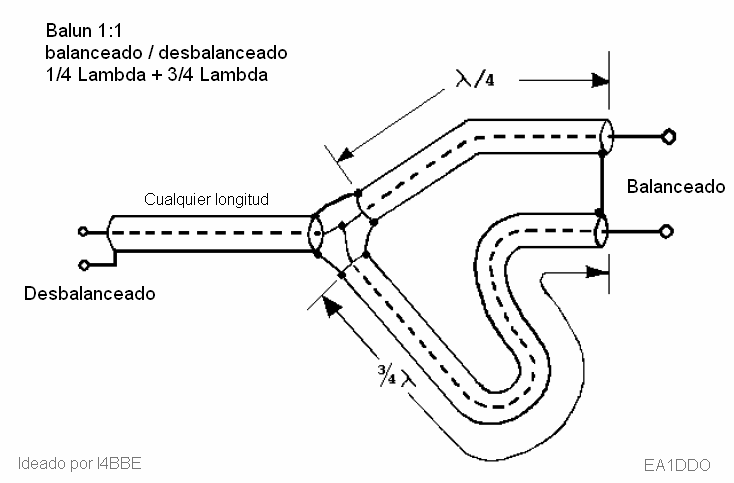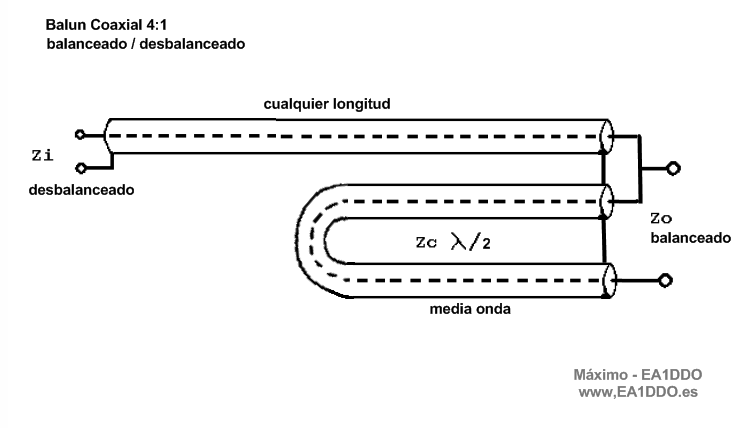Hola.
A ver si algún experto en el tema me podría explicar qué diferencias existen entre un balun 1:1 (que se usa típicamente para poder conectar un dipolo balanceado a un cable coaxial desbalanceado) según la configuración de tres cables en paralelo bobinados al toroide (ver foto anexada) o según la configuración de espiras en contrafase (ver las otras dos fotos anexadas). Yo tengo entendido que esta última configuración se llama Choke balun RFI y sirve para reducir ruido y evitar interferencias, y en este caso se llama unun 1:1. ¿?
¿qué configuración de las dos debería usar para una dipolo que me he fabricado para 50 MHz?
Muchas gracias.
Hola,
Lo que yo creo es que el primero es un balun 1:1
Los otros dos, son simples chokes, con un coaxial dando vueltas a un toroide.
Ambos hacen la misma función, pero de diferentes maneras.
Podrías usar cualquiera de ellos. Los chokes son más sencillos de hacer, pero no tengo claro su rendimiento en 50 MHz. Empieza a ser una frecuencia alta para esos chokes.
De esos tres yo me decantaría por el primero.
De todas formas, yo miraría otros sistemas:
http://www.dg7ybn.de/Symmetrising/Symmetrising.htm
Ahí tienes varios para elegir.
73, Máximo - EA1DDO
Máximo Martín - EA1DDO / HK1H / M0HAO
EA1DDO@HoTMaiL.com
http://www.EA1DDO.es
Hola,yo en mi antena Yagi para 50 MHz cuando la hice note retorno de RF y simplemente me subi a la torre e inserte unas ferritas tipo clip y asunto resuelto, inicialmente puse un choque hecho con RG-58 bobinandolo sobre PVC, aprovechando el cable que puse entre el excitado y el conectoor N de la antena, pero no bastó y como ya estaba arriba la antena pues subi "armado" de ferritas y coloque creo que 5. Bueno el caso como digo es que el tema se normalizo.
Ahora estoy preparando una LFA de 5 El y aun no he decidido que tipo de simetrizador poner.
73.
Mi hijo me hace profundamente feliz
TNX & 73,
Pedro EA4ADJ IM88jw http://ea4adj.jimdo.com/
La solana. Que pueblo, galan!
Hola,
Para antenas monobanda, como por ejemplo para 50 MHz, este es muy recomendable;

Escribió:½ WAVE LENGTH COAX BALUN
Highly recommended where it can be used (usually impractical on HF). This is a very low loss balun.
½ wave loop balun. ½ wave loop balun on 2m folded dipole.This balun works on the same principle as transformer baluns, in fact, it is a transformer balun. One side of the signal is transmitted as is and the other side is produced by delaying the signal by half a wave length. This inverts the signal to produce the opposing one. These baluns work well enough but have the disadvantage of being restricted to a very narrow band of frequencies. They are the best if a narrow bandwidth is what you want. The length of the half wave loop is calculated from both the wavelength and the velocity factor of the cable. RG213 typically has a velocity factor of 66% so for 144.4 MHz the wave length is 299.8/144.4 (2.076 metres) divided by 2 (1.038m) multiplied by velocity factor giving 685 mm. To be sure, consult the technical specifications of the coax you are using.
It is important use the best coax you can for the balun even if you use lousy coax for the feedline. Using heliax is a little impractical because it doesn't bend so easily but something like Benelec LMR400 is ideal. A balun made from this cable will have an insertion loss of about .05db. One side will be driven harder than the other by this amount. It also has a velocity factor of 85% meaning it needs to be longer. The losses will be the nearly the same regardless of frequency. At higher frequencies the loss per metre is higher but you need less of it. Since the electrical fields in both halves of the dipole will affect the other, the average insertion loss will be less than 0.05db, probably about 0.03 but who's counting.
Por la información que yo tengo, este colega australiano habla de ese balun pero lo que no dice es es 4:1

73, Máximo - EA1DDO
Máximo Martín - EA1DDO / HK1H / M0HAO
EA1DDO@HoTMaiL.com
http://www.EA1DDO.es
QDURE - https://qsl.ure.es
Imprime y confirma tus QSL en tan solo tres click.
Nunca fue tan fácil y cómodo
el confirmar tus contactos.
TIENDA ONLINE URE
Publicaciones, mapas, polos, camisetas, gorras, tazas, forros polares y mucho más...
WEBCLUSTER EA4URE
Conoce el nuevo WebCluster de URE, ahora con nuevos filtros e información y compatible con GDURE



